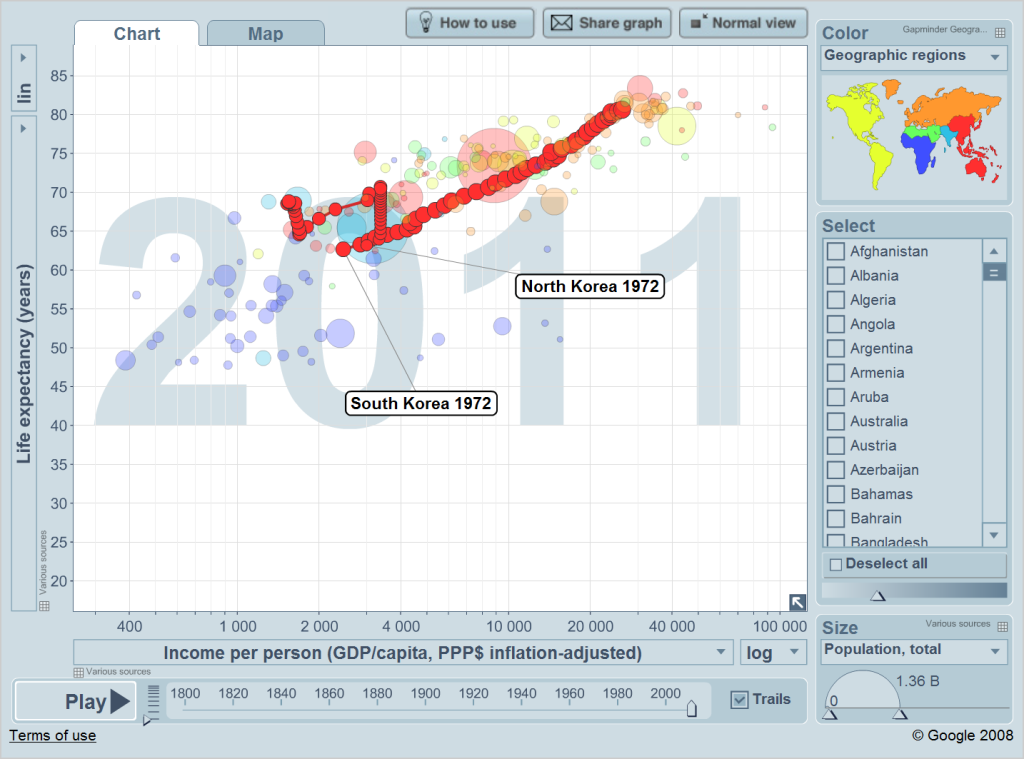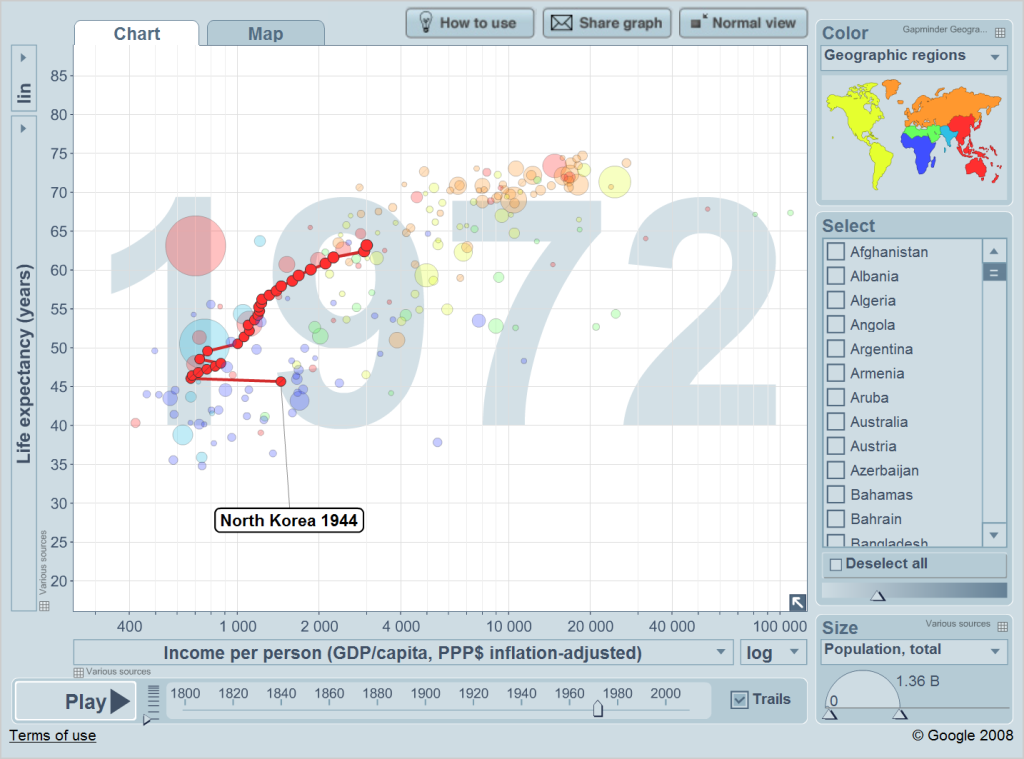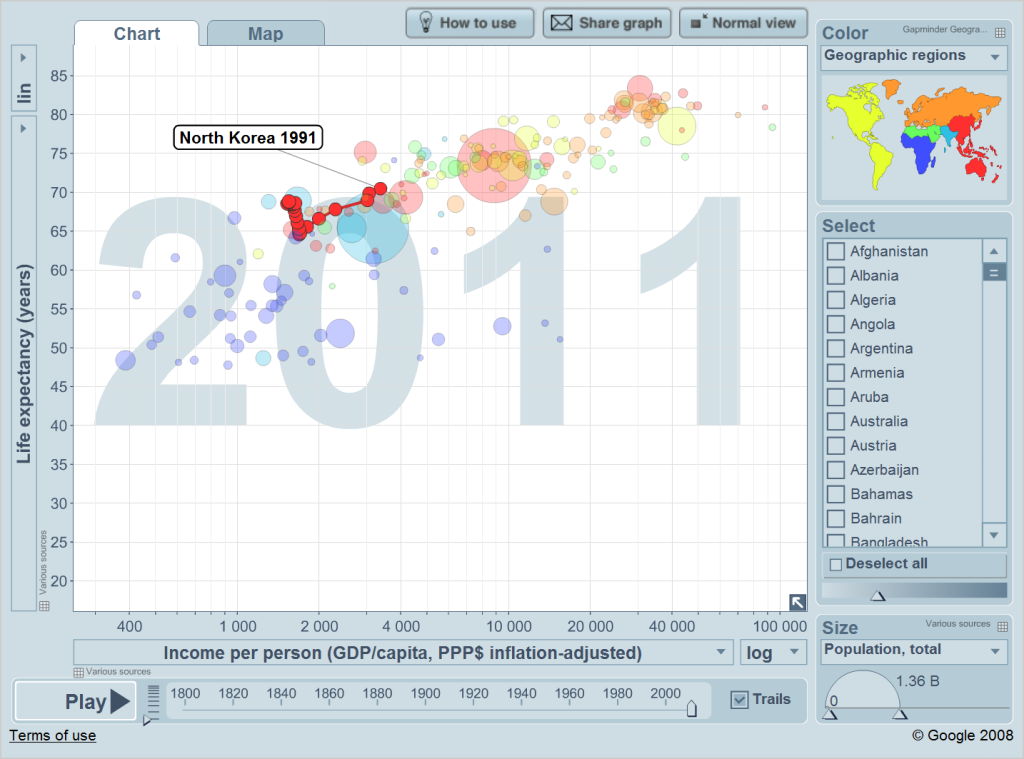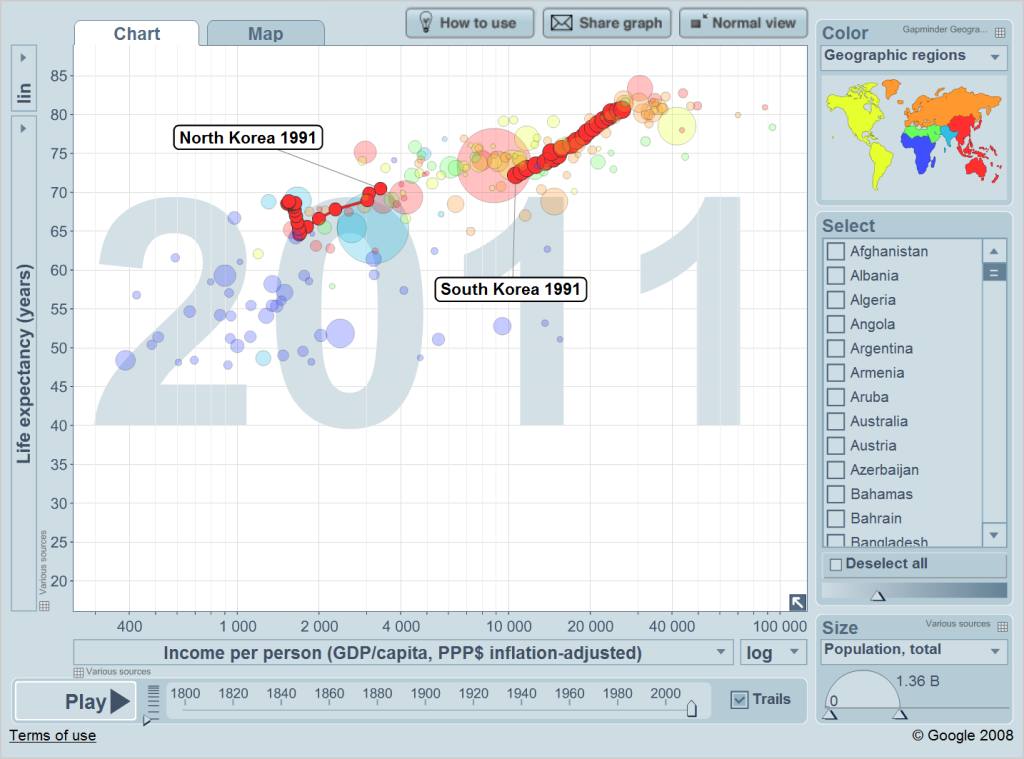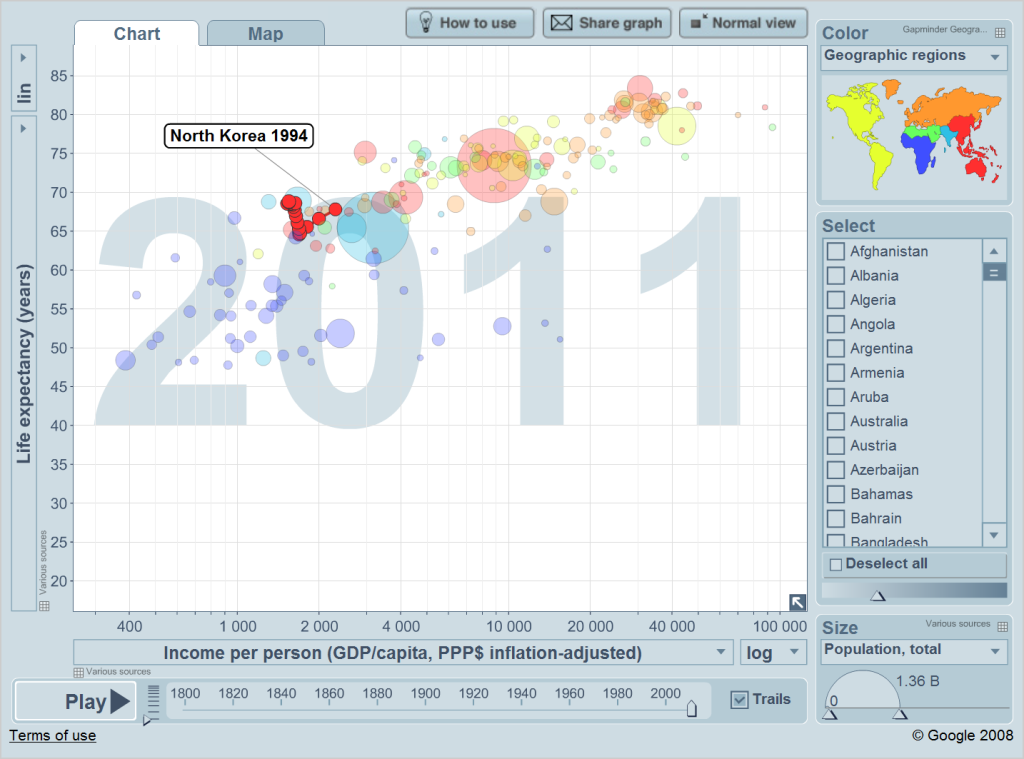This is the second part of two posts examining how North Korea fell behind South Korea.
As the previous post found, for several decades North Korea kept up with South Korea. Then, during the mid-1970s, the country started falling behind. Ever since then the gap between the two countries has widened.
This post will explore several factors behind what caused North Korea to fall behind. There seem to be three main causes: the failed ideology of juche (self-reliance), the end of Soviet aid, and Kim Jong-Il’s incompetent rule.
More below.
Juche
If one looks at Gapminder’s graphic, North Korea and South Korea are neck-and-neck until the mid-1970s:
Then North Korea falls behind:
What caused this? Well, in 1972 North Korea adopted the ideology of juche into the constitution. Juche stands for self-reliance. There’s a lot of fancy Marxist philosophical complexity behind the idea, but in its essence it seems to be basically a fancy form of protectionism.
Juche was very harmful to the North Korean economy. Here is North Korea before the official adaptation of juche:
As is evident, North Korea was progressing during this period. This is not to say that juche wasn’t part of the state’s ideology in these years. Rather, it seems to have played less of a role.
A description on this website provides a good description of the progress during this time:
The 1954-56 three year plan repaired the massive damage caused by the war and brought industrial production back to prewar levels. This was followed by the five- year plan of 1957-61 and the seven year plan of 1961-67. These plans brought about further growth in industrial production and substantial development of state infrastructure. By the 1960s North Korea was the second most industrialized nation in East Asia, trailing only Japan. While a number of internal limitations appeared, such as in the production of consumer goods, the national standard of living was considered by many third-world nations as an alternative to the capitalist model of development sponsored by the United States. Building upon the ruins left by the Korean War, the North Korean economy by the late 1960s provided its people with medical care, universal education, adequate caloric intake, and livable housing.
Here is what happens after the official adoption of juche:
The website continues with a description of North Korea’s economic decline. I will quote the discussion in full because it’s quite comprehensive:
In the 1970s the expansion of North Korea’s economy, with the accompanying rise in living standards, came to an end and a few decades later went into reverse. A huge increase in the price of oil following the oil shock of 1974 hurt the economies of countries throughout the world, North Korea among them. North Korea has no oil of its own, and it had few export commodities of interest to the west. Compounding this was a decision to borrow foreign capital and invest simultaneously in the military and mining industries. North Korea’s desire to gain as much independence as it could from China and Russia prompted the expansion of its military power. They believed such expenditures could be covered by foreign borrowing and increased sales of its minerals in the international market. North Korea invested heavily in its mining industries and purchased a large quantity of extractive machinery and tools from abroad. However, soon after making these investments, the international prices of for many of these minerals fell, leaving North Korea with large debts and an inability to pay off the debts and provide a high level of social welfare to its people.
Adding to the above, the centrally planned economy, which emphasized heavy industry, had reached the limits of its productive potential in North Korea. Juche repeated demands that North Koreans learn to build and innovate domestically had run its course as had the ability of North Koreans to keep technological pace with other industrialized nations. By the mid to late-1970s some parts of the capitalist world, including South Korea, were advancing into new phases of technology and economic development and phasing out the coal-and-steel-based economies of the earlier period.
Kim ll-sung, trapped in an ideology that had once been highly successful, was unable to respond effectively to the challenge of an increasingly prosperous and well-armed South Korea, which undermined the legitimacy of his own regime. Having failed at their earlier attempt to turn to the market and conduct market-economy reforms such as those carried out in China by Deng Xiaoping, Kim opted for continued ideological purity. The DPRK by 1980 was faced with the choice of either repaying its international loans, or continuing its support of social welfare for its people. Given the ideals of Juche, North Korea chose to default on its loans, and by late 1980s its industrial output was declining.
One should note that the images above are models of North Korea’s economic path rather than based on North Korean statistics. Since North Korea doesn’t reveal its GDP, people have to make educated guesses. The people on Gapminder put North Korea as slightly wealthier than South Korea in 1944 and then modeled equal economic growth rates until the mid-1970s. At that point they put 0% GDP per capital growth to model North Korea’s stagnation during that period. Finally, they use slightly more accurate estimates after the fall of the Soviet Union to model North Korea’s famine and its most recent years.
Nevertheless, these models are based off what happened in real life. It’s undeniable that North Korea was stagnating during the late ’70s and ’80s. It’s also undeniable that there was a famine during the late ’90s. So while the graphic isn’t perfect, it’s a decent representation of reality.
The End of Soviet Aid
Juche seems to have been the main turning point in North Korean economic history. Nevertheless, it’s worth noting that there are in fact two “parts” of North Korean economic decline. The first part, during the late ’70s and 80s, is stagnation – when North Korea doesn’t go forward but doesn’t go backwards. The second part starts in the ’90s, when North Korea actually starts going backwards.
What caused this?
Well, for all of its economic history North Korea depended extensively on communist aid. The Soviets were determined to prove that their system was superior and, like the Americans, gave lots of aid to their allies. Eventually it turned out that their system was in fact not superior, and by the end the Soviet Union couldn’t really afford to give out that aid. In 1991 the Soviet Union collapsed and all Soviet aid withdrew.
This hit North Korea hard:
In fact, it eventually created a famine. This graphic shows North Korea after the fall of the Soviet Union. This is the second part of the country’s economic decline, when it actually starts going backwards. Soviet aid was particularly important because the Soviet Union sold North Korea oil at low prices. North Korea’s inefficient economy and agricultural system depended badly on petroleum, but it couldn’t afford to buy petroleum at market prices. When the Soviets stopped giving North Korea oil, North Korea collapsed.
Here’s a comparison with South Korea:
Kim Jong-Il
Kim Jong-Il’s rule was incompetent and terrible for North Korea. Let’s take a look at North Korea under his father Kim Il-sung, until his death in 1994.
We see progress throughout most of Kim Il-sung’s rule. During his final years, however, stagnation and finally decline sets in. Nevertheless, one could say that Kim Il-sung did good for North Korea.
What happens under Kim Jong-Il?
Decline. Indeed, there’s a startling coincidence between Kim Jong-Il’s path to power and North Korea’s economic decline. Kim Jong-Il began taking power during the 1980s. During that time North Korea is well into stagnation. He takes over the armed forces in 1991. North Korea then begins going backwards. His father dies in 1994, leaving him in absolute control. North Korea then suffers a famine from 1994 to 1998.
Here’s North Korea and South Korea during Kim Jong-Il’s rule:
Conclusion
It seems that there were three main events that caused North Korea’s economic decline: juche, the end of Soviet aid, and the incompetence of Kim Jong-Il. Juche turned economic growth into stagnation. The end of Soviet aid turned stagnation into absolute decline. This backwards path gained momentum as Kim Jong-Il gained power and ruled incompetently.
North Korea’s tale is fairly unique. It’s the story of a country which achieved a decent standard of living and high industrialization under communism. Then the strains of the system became apparent, such as the overreliance on petroleum, and it eventually collapsed. This is why one hears of a lot of North Korean factories that used to work but now don’t. One hopes that the new leader Kim Jong-un will turn things around for his people.
–inoljt

